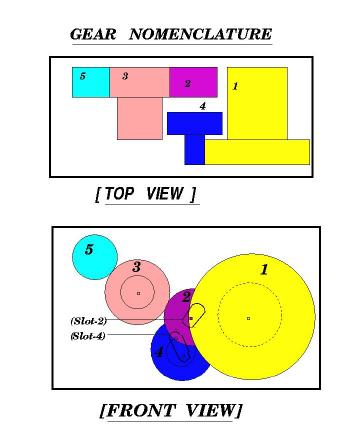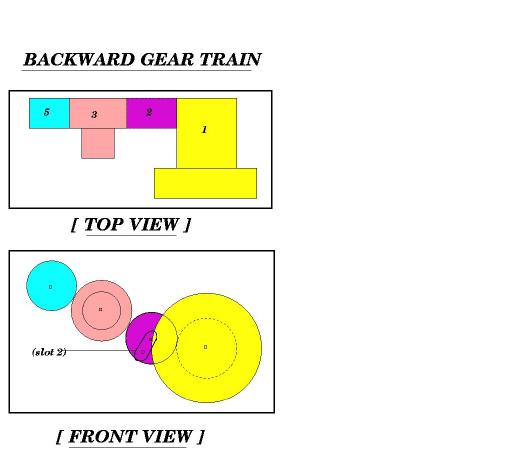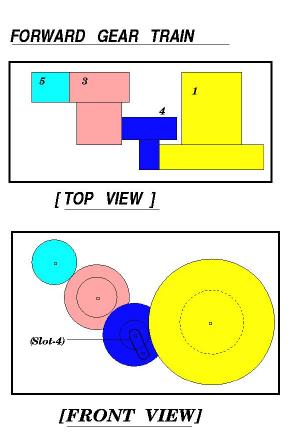

This mode also explains why the car does not return when moved in the forward direction.Here the Gear connections as shown above indicate that moving the forward causes only gears 5, 3 and 2 to move.Also the force exerted on Gear2 by Gear3 is antiparallel to the orientation of its slot,so it does not get connected to Gear 1. hence no energy storage in the spring,and so no backward motion.

The tyres are rubbed against a surface in the backward direction.Now ,due to the no slip condition the tyres start rotating.The rotation is being viewed from such a direction that the tyres move clockwise in this view.Gear 5, which is connected to the rear wheel shaft also starts rotating clockwise.Now Gear 3a,which is meshing with Gear 5 starts rotating in the counter-clockwise direction.This gear is meshed with Gear 2 ,and so Gear 2 rotates clockwise.Also in this mode, Gear 3 exerts tangential force on Gear 2 in the direction of orientation of Gear 2's slot so that under this force Gear 2 moves in its slot and changes its axis and so gets connected to Gear 1b.So Gear 1b rotates counter-clockwise .Now as it is connected to the spring the spring twists and energy is stored in it.
It is important to note that Gear 4 is connected to Gear 1.But it does not form a part of the Gear Train.Gear 1 exerts a force on it , but the direction of the force is perpedicular to the antiparallel to the direction of orientation of slot 4.So it does not move in the slot and does not get connected to Gear 3.It does rotate,which is due to its meshing with Gear 1 , but does not serve any purpose in this motion.

Once sufficient energy is stored,the car is left on the surface. The spring in this stage is in a twisted(deflected) state.Hence it tries to restore its natural shape.As it does so,being in connection with Gear 1,rotates it clockwise.This is meshed with Gear 4a , so Gear 4 starts rotating counter-clockwise.Also, Gear 1 exerts a tangential force on Gear 4 in a direction parallal to the direction of orientation of slot 4.Gear 4, under this force moves in its slot and changes its axis , thereby gets connected to Gear 3b through 4a.Thus Gear 3 rotates clockwise , and since it is connected to Gear 5 through Gear 3a , Gear 5 starts rotating counter-clockwise.Gear 5 is attached to the shaft joining the rear wheels.So the wheels rotate and the car moves forward.Also after the spring regains its original shape,Gear 1 and Hence Gear4 stop moving,and gear 4 gets disconnected from Gear 3.But the car moves forward some more distance because of momentum stored in it.Then the connections after the spring has regained its shape are that of the normal mode.
Here again it is important to note that though in this case Gear 2 is connected only to Gear 3b and does not form part of the train.As soon as the car is left after the input motion , the force on Gear 2 due to Gear 3 changes sign and is now in a direction antiparallel to orientation of slot 2.So Gear 2 gets disengaged from Gear 1 an moves back in its slot to its normal position.It does rotate due to its engagement with Gear 3b ,and like Gear 4 in the backward motion does not serve any purpose.